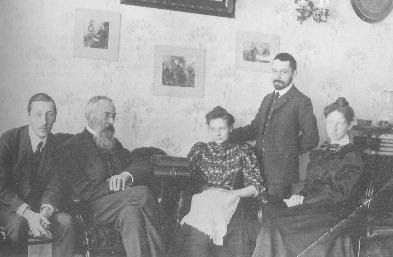
[Igor Stravinsky at 26, looking uncomfortable with teacher Nicolai Rimsky-Korsakov and family, in the year before the premiere of The Firebird (1908)]
Igor Fyodorovich Stravinsky
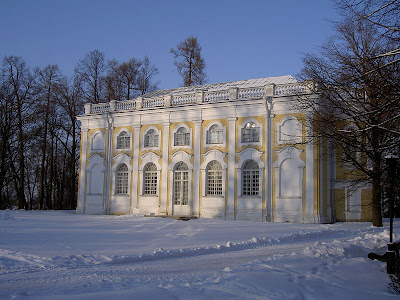
[Pavillion at the Palace of Oranienbaum]
(June 17, 1882, Oranienbaum [Lomonosov], Russia – April 6, 1971) is considered by many to be the most influential composer of 20th century music.
He was a quintessentially cosmopolitan Russian who was named by Time magazine as one of the 100 most influential people of the century.
In addition to the recognition he received for his compositions, he also achieved fame as a pianist and a conductor, often at the premières of his works.

Stravinsky was brought up in Saint Petersburg. His childhood, he recalled in his autobiography, was troublesome: "I never came across anyone who had any real affection for me."
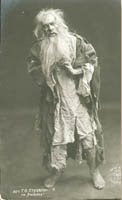
[Fyodor Stravinsky as the Miller in Alexander Dargomyzhsky's opera Rusalka]
Igor's father, Fyodor Stravinsky (1843-1902), was a bass singer

at the Mariinsky Theater in Saint Petersburg, and the young composer-to-be began piano lessons and later studied music theory and attempted some composition. In 1890, Stravinsky saw a performance of Tchaikovsky's ballet The Sleeping Beauty at the Mariinsky Theater; the performance, his first exposure to an orchestra, mesmerized him.
At 14, he mastered Mendelssohn's Piano Concerto in G minor, and the next year, he finished a piano reduction of one of

Alexander Glazunov's string quartets.
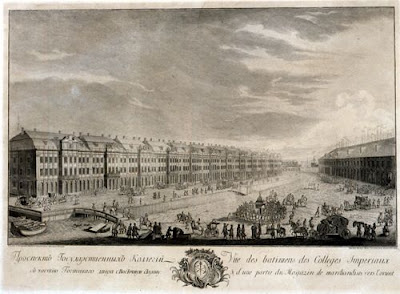
Despite his enthusiasm for music, his parents expected him to become a lawyer. Stravinsky enrolled to study law at the University of St. Petersburg in 1901, but was ill-suited for it, attending fewer than fifty class sessions in four years.
After the death of his father in 1902, he had already begun spending more time on his musical studies. Because of the closure of the university in the spring of 1905, in the aftermath of
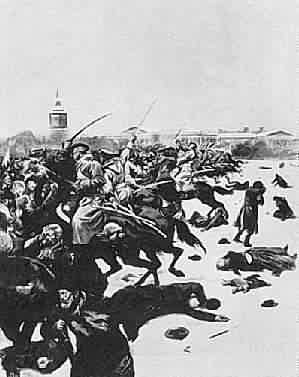
Bloody Sunday (which led to the failed 1905 Revolution, later commemorated by Dmitri Shostakovich in his Symphony No. 11), Stravinsky was prevented from taking his law finals.
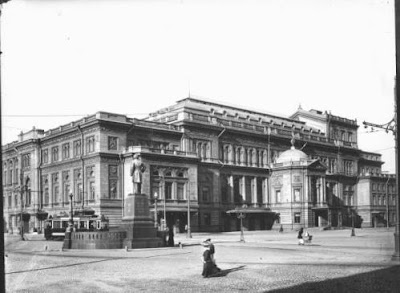
Thereafter, he concentrated on music. On the advice of Nikolai Rimsky-Korsakov, probably the leading Russian composer of the time, he decided not to enter the St. Petersburg Conservatoire; instead, in 1905, he began to take twice-weekly private tutelage from Rimsky-Korsakov, who became like a second father to him.
1905 also saw his betrothal to his cousin Katerina Nossenko, whom he had known since early childhood. They were married on January 23, 1906, three months later receiving a half-course diploma in law (April).
This was also the time of his first acknowledged composition, at 24, Faun and Shepherdess (1906)-- followed soonafter by Symphony in Eb (1907) and the birth of his first children, Fyodor (1907) and Ludmilla (1908).
Stravinsky's career may be divided roughly into three stylistic periods.
The first period (excluding some early minor works) began with Feu d'artifice and achieved prominence with the three ballets composed for Diaghilev. These three works have several characteristics in common: they are scored for an extremely large orchestra; they use Russian folk themes and motifs; and they are influenced by Rimsky-Korsakov's imaginative scoring and instrumentation. They also exhibit considerable stylistic development: from L'oiseau de feu, which emphasizes certain tendencies in Rimsky-Korsakov and features pandiatonicism conspicuously in the third movement, to the use of polytonality in Petrushka, and the intentionally brutal polyrhythms and dissonances of Le Sacre du printemps.
In 1909, his Feu d'artifice (Fireworks), was performed in St Petersburg, and heard by
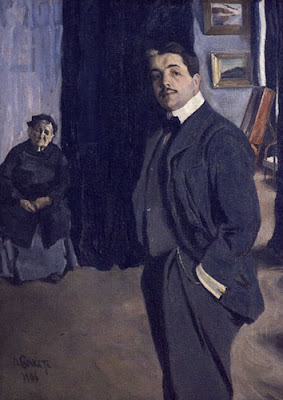
Sergei Diaghilev, the director of the Ballets Russes in Paris, who was sufficiently impressed to commission Stravinsky to carry out some orchestrations, and then to compose a full-length ballet score,
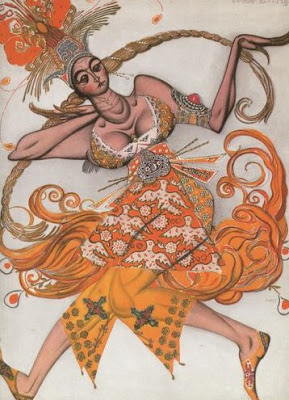
L'Oiseau de feu (The Firebird) (1909)
1882Stravinsky1909Firebird
Introduction
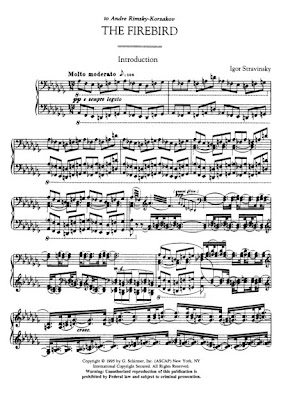 [Introduction - Piano Score]
[Introduction - Piano Score]The first of Stravinsky's Russian ballets, L'Oiseau de feu (The Firebird), is noted for its imaginative orchestration, evident at the outset from the introduction in 12/8 time, which exploits the low register of the double basses.
Infernal Dance of Prince Kashchei [page 118 in the Scribd score above]
 (Piano Score)
(Piano Score)While the sudden boffo big chords of Kaschei recall F.J. Haydn's Symphony No. 9 ("Surprise"), the twisted melody is all its own in A:
Re Me Do Re Me Do
Re Me Do Me Sol Fi (notated Se)
Re Me Do Me Sol Fi
Do Me Sol Fi Me Sol Te La Me Do Fi
The synthetic scale Do Re Me Fi Sol La Te Do (a Dorian/Lydian mix)
Berceuse

[Berceuse - Piano Score]
Finale [page 166 in the Scribd score]
 [7/8 Section and Conclusion, Piano Score, Transposed]
[7/8 Section and Conclusion, Piano Score, Transposed]The beyond-mere-major-key Finale can be analyzed,
discounting drone (pedal) bass, as a bass line mirror solfege of Do Ra Re Fi Re Ra Do,
with chords I bII6 II6 #IVB II6 bII6 I.
Like many of the late romantic composers, Stravinsky often called for huge orchestral forces, especially in the early ballets. His first breakthrough The Firebird proved him the equal of his teacher Nikolai Rimsky-Korsakov and lit the "fuse under the instrumental make up of the 19th- century orchestra." In The Firebird he took the orchestra apart and analyzed it.
Stravinsky travelled to Paris in 1910, meeting Erik Satie and others, to attend the premiere of The Firebird. His family soon joined him, and decided to remain outside of Russia for a time.
While the Stravinskys were in Switzerland, their second son, Soulima (who later became a composer), was born that year.
The composer found recordings to be a practical and useful tool in preserving his own thoughts on the interpretation of his music. As a conductor of his own music, he recorded primarily for Columbia Records, beginning in 1928 with a performance of the original suite from The Firebird and concluding in 1967 with the 1945 suite from the same.
Most of Stravinsky's work from The Firebird onwards was written for specific occasions and was paid for generously.
Stravinsky moved to Switzerland, where he lived in Lausanne (1911) and Clarens (1913-1920).
During this time he composed three further works for the Ballets Russes, including Petrushka (1911), written in Lausanne.
***

[Stravinsky with Vaslav Nijinsky, the original interpreter of the title role in Petrushka]
Petrushka (1911)
1882Stravinsky1911Petrushka
Part I: Opening

Russian Dance [page 44 in the Scribd score]

Part II: In Petrushka's Room [page 64]
Part III: In the Moor's Room: Valse [page 84]
Part IV: Shrove-Tide Fair
***
King of the Stars (1912)
***

[Pablo Picasso - Les Demoiselles d'Avignon (The Maidens [Five Prostitutes] of Avignon, 1907)]

[Jean Cocteau - Stravinsky Playing The Rite of Spring]

The Rite of Spring (1913)
1882Stravinsky1913RiteOfSpring
Part I - Introduction
In The Rite of Spring, Stravinsky attempted to depict musically the brutality of pagan Russia, which inspired the violent motifs that recur throughout the work. Once again, Stravinsky's originality is evident: the opening theme, played on a bassoon at the very top of its register, has become one of the most famous passages in music.
Stravinsky occasionally exploited the extreme ranges of instruments, most famously as above to simulate the symbolic "awakening" of a spring morning.
 Dances of the Adolescents [page 12 in the Scribd score above]
Dances of the Adolescents [page 12 in the Scribd score above]***
The Rite of Spring is notable for its relentless use of ostinati, including the above eighth-note bitonal syncopated ostinato on strings accented by eight horns. The work also contains passages where several ostinati clash against one another.
According to Philip Glass:
"the idea of pushing the rhythms across the bar lines . . led the way. . . [T]he rhythmic structure of music became much more fluid and in a certain way spontaneous."
Glass also praises Stravinsky's "primitive, offbeat rhythmic drive."
According to Andrew J. Browne, "Stravinsky is perhaps the only composer who has raised rhythm in itself to the dignity of art."
Stravinsky's rhythm and vitality greatly influenced composer Aaron Copland.
***
Games of Rival Towns
Entrance of the Sage
Part II
Dance of the Chosen One

Sacrificial Dance
***

[Stravinsky in 1913]
Le Sacre du printemps (The Rite of Spring) (1913) was written in Clarens.
If Stravinsky's stated intention in his youth (re his associates and family) was "to send them all to hell," then he may have rated the 1913 première of Le sacre du printemps as a success: it is among the most famous music riots, and Stravinsky referred to it frequently as a "scandale" in his autobiography.
There were reports of fistfights among the audience, and the need for a police presence during the second act. The real extent of the tumult, however, is open to debate, and these reports may be apocryphal.
Stravinsky later commented about the première of The Rite: "As for the actual performance, I am not in a position to judge, as I left the auditorium at the first bars of the prelude, which had at once evoked derisive laughter. I was disgusted. These demonstrations, at first isolated, soon became general, provoking counter-demonstrations and very quickly developing into a terrific uproar. During the whole performance I was at Nijinsky's side in the wings. He was standing on a chair, screaming 'Sixteen, seventeen, eighteen'--they had their own method of counting to keep time. Naturally the poor dancers could hear nothing by reason of the row in the auditorium and the sound of their own dance-steps. I had to hold Nijinsky by his clothes, for he was furious, and ready to dash on to the stage at any moment and create a scandal. Diaghilev kept ordering the electricians to turn the lights on or off, hoping in that way to put a stop to the noise. That is all I can remember about that first performance."
In Le Sacre, Stravinsky stripped folk themes to their most basic melodic outlines, and often contorted them beyond recognition with added notes, and other techniques including inversion and diminution. Only in recent scholarship, such as described in Richard Taruskin's Stravinsky and the Russian Traditions, have analysts uncovered the original source material for some of the music in The Rite.
The ballet has been characterized by Aaron Copland as the foremost orchestral achievement in 20th century.
The Stravinskys' second daughter, Maria Milena, was born in 1913. During this last pregnancy, Katerina was found to have tuberculosis, and she was placed in a Swiss sanatorium for her confinement. After a brief return to Russia in July 1914 to collect research materials for Les Noces, Stravinsky left his homeland and returned to Switzerland just before the outbreak of World War I brought about the closure of the borders. He was not to return to Russia for nearly 50 years. Stravinsky was one of the few Eastern Orthodox or Russian Orthodox community representatives living in Switzerland at that time and is still remembered as such in Switzerland to date.
Other pieces from the Russian period include: Le Rossignol (The Nightingale) and Renard (1917).
***

The Nightingale (1914)
Pribaoutki Songs (1914)
Three Pieces for String Quartet (1914)
Cats Cradle Songs (1916)
Renard (1917)
***
The next phase of Stravinsky's compositional style extended from roughly from 1918-1920 to about 1951. The Soldier's Tale (1918), Pulcinella (1920), and the Octet (1923) for wind instruments are among Stravinsky's first compositions to feature his re-examination of the older musics and world styles outside of the Russian tradition. For this "neo-classical" style Stravinsky often abandoned the large orchestras demanded by the ballets, and turned instead largely to wind instruments, the piano, and choral and chamber works.
Stravinsky may have been preceded in his use of neoclassical devices by other composers, including Erik Satie and Sergei Prokofiev (the latter's Symphony No. 1 ["Classical"] of 1917].
By the late 1920's and 1930's, the use by composers of neoclassicism had become widespread.
***

Stravinsky wrote for unique combinations of instruments in smaller ensembles, chosen for their precise tone colours. Histoire du soldat (The Soldier's Tale) is scored for clarinet, bassoon, cornet, trombone, percussion, violin, and double bass -- a strikingly unusual combination for 1918.
Histoire du Soldat (The Soldier's Tale) (1918)
 The Soldier's March
The Soldier's MarchRoyal March
Tango - Waltz - Ragtime
The Devil's Dance
The Great Chorale
Triumphant March of the Devil
***
Composer Constant Lambert described pieces such as Histoire as containing "essentially cold-blooded abstraction."
Lambert continued, "melodic fragments in Histoire du Soldat are completely meaningless themselves. They are merely successions of notes that can conveniently be divided into groups of three, five, and seven and set against other mathematical groups", and he described the cadenza for solo drums as "musical purity...achieved by a species of musical castration." He compared Stravinsky's choice of "the drabbest and least significant phrases" to Gertrude Stein's: "Everyday they were gay there, they were regularly gay there everyday" ("Helen Furr and Georgine Skeene," 1922), "whose effect would be equally appreciated by someone with no knowledge of English whatsoever."
Jean Cocteau commented deprecatingly on Stravinsky in his 1918 book Le Coq et l'Arlequin.
"All the signs indicate a strong reaction against the nightmare of noise and eccentricity that was one of the legacies of the war.... What has become of the works that made up the program of the Stravinsky concert which created such a stir a few years ago? Practically the whole lot are already on the shelf, and they will remain there until a few jaded neurotics once more feel a desire to eat ashes and fill their belly with the east wind."
Of course, the major early Stravinsky ballets are still now very much in the repertory, whereas now Cocteau's remarks as above are merely an historical curiosity.
***
Rag-time (1918)
Piano Rag Music (1919)
***
Stravinsky displayed an inexhaustible desire to explore and learn about art, literature, and life.
This desire manifested itself in a number of his Paris collaborations. Not only was he the principal composer for Ballets Russes, but he also collaborated with Pablo Picasso, who became Diaghilev's designer, in Pulcinella (1920, written in Clarens).

Picasso took the opportunity to make several

sketches

of the composer.
***

Pulcinella (1920)

Sinfonia (Overture)
Serenata
Vivo (Duetto)
Finale
***
Stravinsky continued a long tradition, stretching back at least to the 15th Century in the form of the quodlibet and parody mass, by composing pieces which elaborate on individual works by earlier composers. An early example of this is Pulcinella, in which he used (at Diagilev's suggestion) music which at the time was attributed to Giovanni Pergolesi as source material, at times quoting it directly and at other times reinventing it.
Stravinsky moved to France in 1920, where he formed a business and musical relationship with the French piano manufacturer Pleyel. Essentially, Pleyel acted as his agent in collecting mechanical royalties for his works, and in return provided him with a monthly income and a studio space in which to work and to entertain friends and business acquaintances. He also arranged, one might say re-composed, many of his early works for the Pleyela, Pleyel's brand of player piano, in a way that makes full use of the piano's 88 notes, without regard for the number or span of human fingers and hands. These were not recorded rolls, but were instead marked up from a combination of manuscript fragments and handwritten notes by the French musician, Jacques Larmanjat, who was the musical director of Pleyel's roll department.
Stravinsky later claimed that his intention had been to give listeners a definitive version of the performances of his music, but since the rolls were not recordings, it is difficult to see how effective this intention could have been in practice. While many of these works are now part of the standard repertoire, at the time many orchestras found his music beyond their capabilities and unfathomable. Major compositions issued on Pleyela piano rolls include The Rite of Spring, Petrushka, Firebird, Les Noces, and Song of the Nightingale. During the 1920's he also recorded Duo-Art rolls for the Aeolian Company in both London and New York, not all of which survive.
Patronage was never far away. From this time, Leopold Stokowski gave Stravinsky regular support through a pseudonymous "benefactor."
Symphonies of Wind Instruments (1920)
***
Le Cinq Doigts (The Five Fingers) (1921) (Eight Instrumental Miniatures)
Andantino
Vivace
Lento
***
Although his marriage to Katerina endured for 33 years, the love of Stravinsky's life, and later his partner until death, was his second wife Vera de Bosset (1888-1982).
Stravinsky met de Bossett) in Paris in February 1921, she was married to the painter and stage designer Serge Sudeikin, but they soon began an affair which led to her leaving her husband. From then until Katerina's death from cancer in 1939, Stravinsky led a double life, spending some of his time with his first family and the rest with Vera. Katerina soon learned of the relationship and accepted it as inevitable and permanent.
Erik Satie wrote an article about Igor Stravinsky that was published in Vanity Fair (1922).
Satie's attitude towards the Russian composer is marked by deference, as can be seen from the letters he wrote him in 1922, preparing for the Vanity Fair article. With a touch of irony, he concluded one of these letters "I admire you: are you not the Great Stravinsky? I am but little Erik Satie." In the published article, Satie argued that measuring the "greatness" of an artist by comparing him to other artists, as if speaking about some "truth," is illusory: every piece of music should be judged on its own merits, not by comparing it to the standards of other composers.
***
Mavra (1922)
Les Noces (The Wedding) (1923)
Piano Concerto (1923)
Serenade in A (1925)

Oedipus Rex (1927), the drama in collaboration with Jean Cocteau.

[George Balanchine and Igor Stravinsky, later in life]
Apollo (1928), ballet in collaboration with George Balanchine
The Fairy's Kiss (1928, after music of Peter Tchaikovsky)
Capriccio for Piano and Orchestra (1929)
***

[Stravinsky at 48 (1930)]
Symphony of Psalms (1930)
I
II

III
***
Violin Concerto (1931)
Persephone (1934, text by André Gide)
***
After a short stay near Paris, he moved with his family to the south of France; he returned to Paris in 1934, to live at the rue Faubourg St.-Honoré. Stravinsky later remembered this as his last and unhappiest European address; his wife's tuberculosis infected his eldest daughter Ludmila, and Stravinsky himself.
In 1935, Marc Blitzstein compared Stravinsky to Jacopo Peri and C. P. E. Bach, conceding that "There is no denying the greatness of Stravinsky. It is just that he is not great enough."
Blitzstein's Marxist position is that Stravinsky's wish was to "divorce music from other streams of life," which is "symptomatic of an escape from reality," resulting in a "loss of stamina his new works show," naming specifically Apollo, Capriccio, and Le Baiser de la fée.
***
The Card Party: Ballet in Three Deals (1936)
Prelude for Jazz Band (1937)
Concerto ("Dumbarton Oaks") (1938)
***
Ludmila died in 1938, Katerina in the following year. While Stravinsky was in hospital, where he was treated for five months, his mother also died. Stravinsky already had contacts in the United States; he was working on the Symphony in C for the Chicago Symphony Orchestra, and had agreed to lecture in Harvard during the academic year of 1939-40. When World War II broke out in September, he set out for the United States.
Both Stravinsky and de Bossett left France for the USA, to escape the war (Stravinsky in 1939 after Katerina's death, de Bossett following in 1940). Stravinsky and de Bossett were married in Bedford, MA, USA, on March 9, 1940.
***
Symphony in C (1940)
Tango (1940)
***

[Stravinsky at c. 68, with Walt Disney, re the usuage of The Rite of Spring in Fantasia (1940)]

Stravinsky took up residence in Hollywood in 1940.
***
Circus Polka (1942, after Franz Schubert, for Barnum & Bailey Circus)
Four Norwegian Moods (1942)
Scherzo a la Russe (1944)
**

Ebony Concerto (1945), written for Woody Herman's jazz band
I. Moderato
II. Andante
III.
***
Symphony in Three Movements (1945)
***
Stravinsky continued to live in the United States until his death in 1971; he became a naturalized citizen in 1945. Stravinsky had adapted to life in France, but moving to America at the age of 58 was a very different prospect. For a time, he preserved a ring of emigré Russian friends and contacts, but eventually found that this did not sustain his intellectual and professional life. He was drawn to the growing cultural life of Los Angeles, especially during World War II, when so many writers, musicians, composers, and conductors settled in the area; these included Otto Klemperer, Thomas Mann, Franz Werfel, George Balanchine, and Arthur Rubinstein. He lived fairly near to Arnold Schoenberg, though he did not have a close relationship with him. Bernard Holland notes that he was especially fond of British writers who often visited him in Beverly Hills, "like W. H. Auden, Christopher Isherwood, Dylan Thomas (who shared the composer's taste for hard spirits), and, especially, Aldous Huxley, with whom Stravinsky spoke in French."
He settled into life in Los Angeles and sometimes conducted concerts with the Los Angeles Philharmonic at the Hollywood Bowl as well as throughout the U.S. When he planned to write an opera with W. H. Auden, the need to acquire more familiarity with the English-speaking world coincided with his meeting the conductor and musicologist Robert Craft. Craft lived in the Stravinsky home until the composer's death, acting as interpreter, chronicler, assistant conductor, and factotum for countless musical and social tasks.
***

[Stravinsky at 64 (1946)]
Concerto in D for Strings (1946)
Orpheus (1947)
***
Mass (1948)
I. Kyrie
II. Gloria
III. Credo
IV. Sanctus
V. Agnus Dei
***
In his book Philosophy of Modern Music (1949), Theodor Adorno called Stravinsky an acrobat, a civil servant, a tailor's dummy, hebephrenic, psychotic, infantile, fascist, and devoted to making money.
Part of the composer's error, in Adorno's view, was his neo-classicism, but more important was his music's "pseudomorphism of painting," playing off le temps espace (time-space) rather than le temps durée (time-duration) of Henri Bergson.
"One trick characterizes all of Stravinsky's formal endeavors: the effort of his music to portray time as in a circus tableau and to present time complexes as though they were spatial. This trick, however, soon exhausts itself."
His "rhythmic procedures closely resemble the schema of catatonic conditions. In certain schizophrenics, the process by which the motor apparatus becomes independent leads to infinite repetition of gestures or words, following the decay of the ego."
***

[Igor Stravinsky - The Rake's Progress (1951), San Francisco Opera production, 2007]
The Rake's Progress (1951): Act I, Scene II
Stravinsky completed his last neo-classical work, the opera The Rake's Progress, in 1951, to a libretto by W. H. Auden based on the etchings of Hogarth, staged by the Metropolitan Opera in 1953. It was presented by the Santa Fe Opera in its first season in 1957 with Stravinsky in attendance, and this marked the beginning of his long association with that company. The music is direct but quirky, borrowing from classic tonal harmony but also interjecting surprising dissonances, featuring Stravinsky's trademark off-rhythms, and harkening back to the works Monteverdi, Gluck, and Mozart.
Stravinsky began using dodecaphony, the 12-tone technique originally devised by Arnold Schoenberg, in the early 1950's (after Schoenberg's death), with the encouragement of Robert Craft.
He first experimented with non-12-tone serial technique in small-scale vocal and chamber works such as the Cantata (1952), Septet (1953), and Three Songs from Shakespeare (1953), and his first composition to be fully based on serial principals is In Memoriam Dylan Thomas (1954).
Cantata (1952)

[Stravinsky at 71 (1953)]
Babel (1953)
Septet (1953)
Three Songs from William Shakespeare (1953)
In Memoriam Dylan Thomas (1954)
Greeting Prelude (1955, for Pierre Monteux's 80th birthday, after "Happy Birthday to You")
***

Agon (1957)
 [Two-Piano Manuscript]
[Two-Piano Manuscript] [Full Score]
[Full Score]Pas-de-Quatre
Double Pas-de-Quatre
Second Pas-de-Trois: Bransle Simple

Bransle Gay
Agon (1957) was Stravinsky's first work to include a 12-note series, and Canticum Sacrum (1955) his first piece to contain a movement entirely based on a tone row ("Surge, aquilo").
The former is choreographed for twelve dancers, and an important transitional composition between Stravinsky's neo-classical period and his serial style. Some numbers of Agon are reminiscent of the "white-note" pantonality of the his neoclassic period, while others (for example Bransle Gay) display his re-interpretation of serial methods.
Stravinsky later expanded his use of dodecaphony in works including Threni (1958), A Sermon, a Narrative, and a Prayer (1961), and The Flood (1962) -- all based on biblical texts.
***
Threni (1958)
Movements for Orchestra (1959)
A Sermon, a Narrative, and a Prayer (1961)
***
In 1962, he accepted an invitation to return to Saint Petersburg (Leningrad) for a series of concerts. He spent more than two hours speaking with Soviet leader Nikita Khrushchev, who urged him to return to the Soviet Union.
***
The Dove Descending (1962)
The Flood (1962)
Abraham and Isaac (1963)

[Stravinsky at 82, with Robert Craft (1964)]
Elegy for J.F.K. (1964)
Fanfare for a New Theatre (1964, commissioned for the Kennedy Center, Washington, D.C.)
Variations for Orchestra (1964)
Introitus, T.S. Eliot in Memoriam (1965)
***
Requiem Canticles (1966)
Introit
Dies Irae
Tuba Mirum
***
The Owl and the Pussycat (1966)
***
Stravinsky moved to New York City in 1969, but for the last three years of his life there were no new compositions forthcoming, living at Essex House.
He died at the age of 88 in New York and

was buried in Venice on the cemetery island of San Michele.

His grave is close to the tomb of his long-time collaborator Diaghilev. Stravinsky's professional life had encompassed most of the 20th Century, including many of its modern classical music styles, and he influenced composers both during and after his lifetime. He has a star on the Hollywood Walk of Fame at 6340 Hollywood Boulevard.
His taste in literature was wide, and reflected his constant desire for new discoveries. The texts and literary sources for his work began with a period of interest in Russian folklore, progressed to classical authors and the Latin liturgy, and moved on to contemporary French and eventually English literature, including Auden, T. S. Eliot, and medieval verse.
Stravinsky proved adept at playing the part of "man of the world," acquiring a keen instinct for business matters and appearing relaxed and comfortable in many of the world's major cities.
Paris, Venice, Berlin, London and New York City all hosted successful appearances as pianist and conductor. Most people who knew him through dealings connected with performances spoke of him as polite, courteous and helpful. For example, Otto Klemperer, who knew Arnold Schoenberg well, said that he always found Stravinsky much more co-operative and easy to deal with.
At the same time, he had a marked disregard for those he perceived to be his social inferiors: Robert Craft was embarrassed by his habit of tapping a glass with a fork and loudly demanding attention in restaurants.
Although a notorious philanderer (who was rumoured to have affairs with high-profile partners such as Coco Chanel), Stravinsky was also a family man who devoted considerable amounts of his time and expenditure to his sons and daughters.
"One of music's truly epochal innovators," the most important aspect of Stravinsky's work aside from his technical innovations, including in rhythm and harmony, is the,"changing face," of his compositional style while always, "retaining a distinctive, essential identity." He himself was inspired by different cultures, languages and literatures. As a consequence, his influence on composers both during his lifetime and after his death was, and remains, considerable. "No other composer of the twentieth century exerted such a pervasive influence or dominated his art in the way that Stravinsky did during his five-decade musical career."
Stravinsky's use of motivic development (the use of musical figures that are repeated in different guises throughout a composition or section of a composition) included additive motivic development. This is where notes are subtracted or added to a motif without regard to the consequent changes in meter. A similar technique may be found as early as the sixteenth century, for example in the music of Cipriano de Rore, Orlandus Lassus, Carlo Gesualdo, and Giovanni de Macque, music with which Stravinsky exhibited considerable familiarity, at least later in life.

[The Firebird: Finale / Petrushka: Chez Petrushka
Petrushka: Russian Dance / Rite of Spring: Premiere Tableau]
[8883 Webern /8882 Stravinsky / 8881 Bartok]
